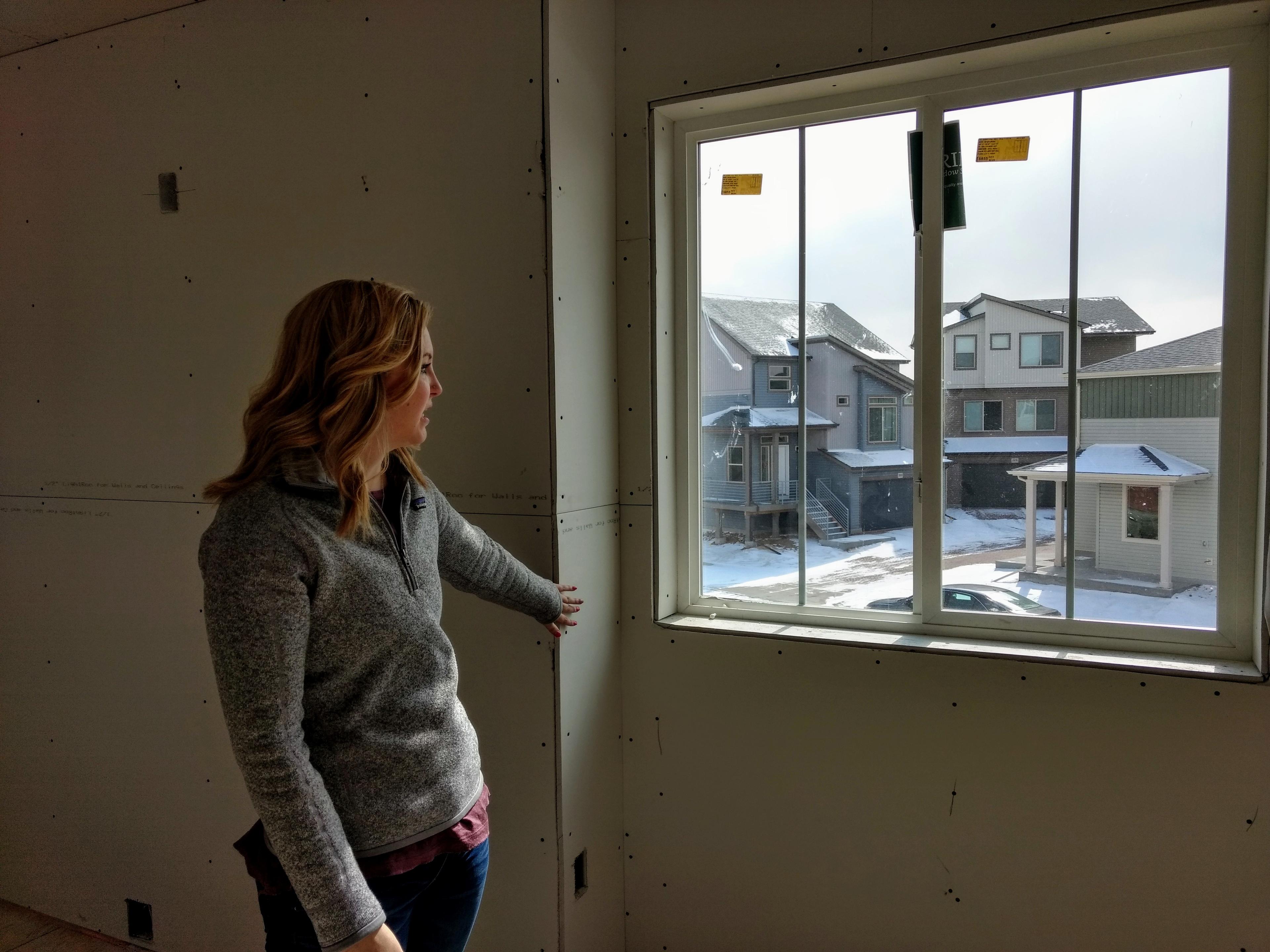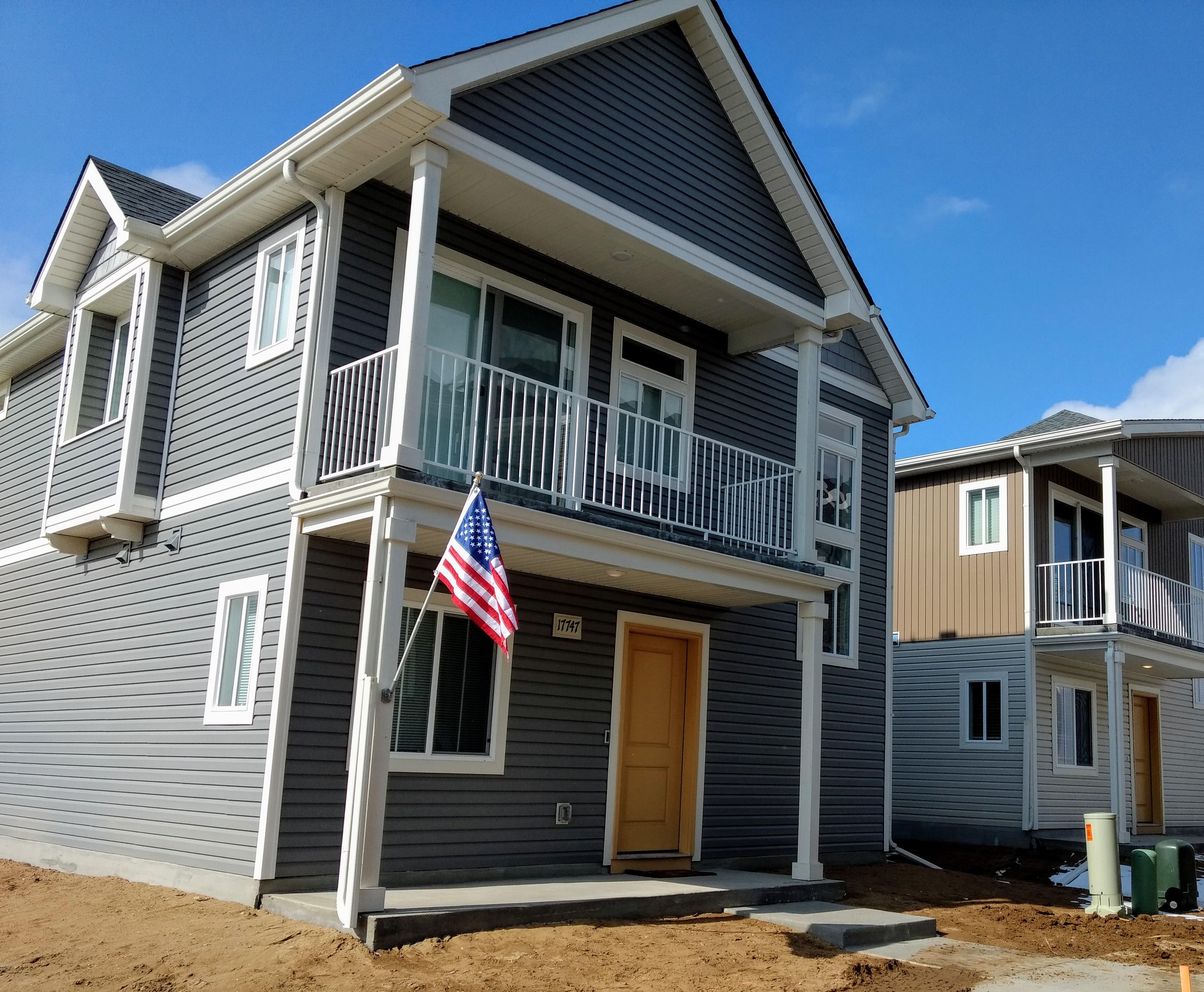Corrie Sahling and her boyfriend Carson Giles moved in with her parents to save up to buy a house.
It's not as bad as it sounds. Within months of trading their Westminster apartment for a Littleton basement, they'd found a Denver house that was in their budget. After the downpayment, they even had some savings left.
Sahling, a 25-year-old second-grade teacher, and Giles, a 23-year-old professional dirt biker and occupational therapy assistant, are among the beneficiaries of a pilot project by Colorado developer Oakwood Homes to build more efficiently and pass the savings on to buyers. The couple's two-bedroom, two-bathroom, two-car-garage Green Valley Ranch home is one of the 24 in Oakwood's American Dream collection that sell for less than $300,000. According to the latest report from the Denver Metro Association of Realtors, the average home in the area sold for $448,132 in January, up 2.89 percent from $461,101 last January.
Sahling said she and Giles, who moved in with her parents in August, had seen what prices were and hadn't had much hope of finding something that worked for them below $350,000. Then Giles saw a Facebook ad about American Dream -- one of the cost-savings with which Oakwood has experimented is relying more on social media to get the word out. Sahling and Giles decided to take a weekend drive out to Green Valley Ranch. They liked what they saw. When Sahling mentioned to the sales team that she was a teacher, they learned Oakwood was offering a 5 percent discount for educators. Their price tag was $275,000 and their monthly mortgage and other housing costs of about $2,000 are reasonable compared to the $1,200 they were paying to rent a smaller place.
"It must have been fate or something," Sahling said. "We'd just decided, 'Let's go look.' And now, here we are."

They expect to move in in April. Sahling seems to be only half joking when she says the second bedroom might be for her 23-year-old brother, who also lives with their parents. He finds Denver rents too high.
Oakwood seeks out cost-cutting measures that trickle down to buyers.
Oakwood Chief Operating Officer Scott Thorson said some of the savings came from small steps, like cutting back on traditional advertising in favor of Facebook posts or sending some financial documents via two-day rather than overnight courier.
"These costs, they all roll back to the homeowner eventually," he said. "We had to save little pieces here, little pieces there."
Based on periodic surveys of builders, the National Association of Home Builders has seen a steady increase in construction costs. The price of building a single-family home almost doubled from $124,276 in 1998 to $237,760 in 2017, when Oakwood began taking a hard look at its costs. The assessment began by bringing together staff from a variety of departments -- purchasing, sales, finance -- and subcontractors.
"It really did start with a conversation," said Don Carpenter, Oakwood's head of product development. The goal was to "sit down and partner with our vendors and our labor force."
Oakwood isn't the only builder confronting costs, or using conversations to find a solution.
Gene Myers, CEO of Thrive Home Builders, said his Denver-based company assembled what he called a vendors council about a year ago to improve efficiency. The council put together a handbook on scheduling and other job site concerns.
"It's kind of a collaboration between our contractors to help each other be as efficient as possible," Myers said. "The ideas for affordable housing really have to start with the experts, and they're the people doing it every day."
He added Thrive's commitment to energy efficiency means homeowners will save on utility bills, saying that also should be seen as an aspect of affordability.
At Oakwood, executives also turned to parent company Clayton Homes, which is America's largest manufacturer of pre-fab homes. The aptly-named Carpenter said Oakwood at first thought it could cut costs by having home components put together at factories owned by Tennessee-based Clayton. But the costs of then getting the parts to Colorado outweighed any savings.
Carpenter said Oakwood is considering opening a factory in Colorado. In the meantime, it has brought some factory-like practices to the field. For example, the bathrooms on different floors in an American Dream homes are stacked atop each other, streamlining the work of plumbers. According to the homebuilders group surveys, just over 28 percent of the cost of building a home is in the interior finishes -- plumbing, painting, appliances.
Vendors and subcontractors worked out scheduling so that materials were on hand and other workers out of the way when needed.
"A lot of the savings isn't in the actual materials. It's time," Carpenter said. "Every day we're under construction is money for us."
All the bathrooms in each of the seven American Dream models are the same. Four kitchen styles feature counters designed with few corners to cut waste. Cabinets and windows come in just a few sizes. This standardization saves time and money.
The homes, all in earth-tone siding, are built in the much-maligned row style in groups of seven or eight off shared driveways, saving the costs of cutting and pouring pavement.
Sahling said her American Dream doesn't feel cheap.
"I think it's really cute," she said. "They didn't skimp on finishes. It's very well done. The paint feels like a nice finish. The cabinets are good quality. It's big enough."
The couple had, Sahling said, to"find a balance between what we could afford and what we could accept."
The two didn't get a basement for gear or a big yard and dog door for their Rhodesian Boxer. But they can see a park and a trail from the windows of their as-yet-unfinished kitchen, which flows loft-like into eating and living spaces. Also nearby is a station for the commuter rail that Giles will use to get to work at St. Anthony Hospital in Lakewood. Sahling's trip to Reunion Elementary will be cut from a drive of at least an hour to one of 15 minutes.
"It's our first home and we get to own our home in our 20s," she said. "We'll be able to grow financially."

She and Giles want children and see this first home as an investment that will allow them one day to buy a larger home for a larger family.
Rezoning and rethinking land use can change everything.
The American Dreams come in seven plans that range from 997 to 1,700 square feet. According to the most recent US Census estimates, the median size of a new single-family home sold in 2017 was 2,457 square feet.
Those smaller American Dream homes sit on lots of 2,800 or 2,900 square feet. Carpenter, Oakwood's head of product development, said the company's smallest lot until American Dream was 3,600 square feet. The homes are each three stories and rooms can be configured to suit. A buyer, for example, might want a third bedroom instead of space for a second car in the garage.
"How do you reduce the cost of the land? You fit more on the land," Oakwood's Thorson said.
Kyle Dalton, Denver's principal city planner, said a code overhaul in 2010 removed a citywide 6,000-square foot minimum lot size and that was followed a few years later by the easing of health code regulations on the size of a house. Those steps, Dalton said, eliminated "barriers to affordable housing through zoning.
"You can build as small of a house as you want to in Denver and there won't be a zoning or health code in your way," Dalton said.
Thorson praised Denver policymakers for embracing density, an issue any rezoning hearing shows can be controversial.
"Denver talks about wanting to solve the issue of affordable housing. And then does something about it," Thorson said, adding Oakwood's American Dream experiment could be replicated elsewhere if "you can get municipalities to work with you on density solutions."
Those rezoning hearings also show that some Denver residents object to affordable housing because they are suspicious of who might move in. Thorson said that's one reason Oakwood has positioned American Dream homes as housing for key workers with its discounts for not only teachers but first responders and members of the military.
Thorson, an ex-firefighter, added the discounts were a matter of principle. Key workers should be able to live in the communities that depend on their services, he said.













